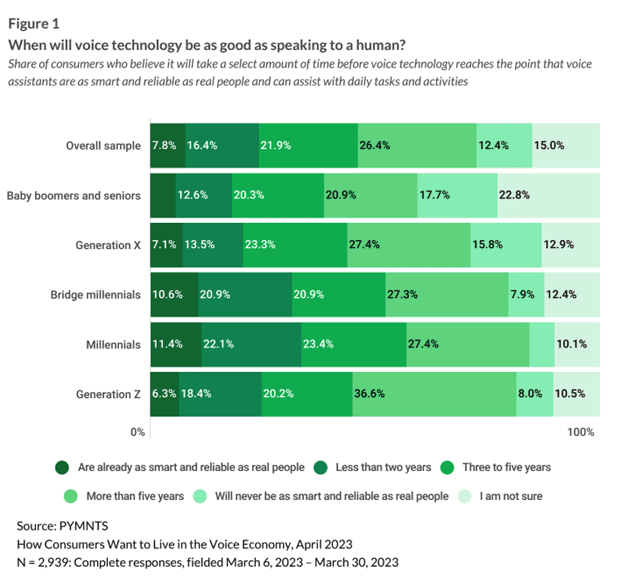63% of Consumers Want an AI-Powered Voice Assistant to Help With Every Day Tasks

The next interface set to revolutionize consumer lives is also the oldest: voice.
Connected devices are rapidly entering a modern hands-free, voice-driven era, as next-generation advances are made in voice recognition technology and increasingly being brought to market across a wide variety of conversational commerce use cases.
This, as findings from PYMNTS’ landmark March 2023 study, “How Consumers Want To Live In The Voice Economy,” finds that around four in every ten consumers believe it will be less than five years until voice recognition technology is advanced enough to make speaking to voice assistants comparable to speaking with actual humans.

Younger generations, like bridge millennials and millennials, believe that time is even closer — and may be here already.
Read More: Consumers Want to Live in a Conversational Voice Economy
More than one in ten members of the millennial (11.4%) and bridge millennial (10.6%) generational cohorts say that they already consider the experience of interacting with artificially intelligent (AI) voice tools today to be as comparably smart and reliable as talking with a human.
For consumers who want to enhance their everyday routines by making commonplace actions smarter, simpler, and more connected, hands-free voice technologies offer a transformative opportunity.
Currently, 63% of consumers say they would use voice if it were as capable as a person, while 58% would use voice because it is easier and more convenient and 54% because it is faster than typing or using a touchscreen.
Around a third of Americans, or 168 million consumers, already use voice to conduct at least six different everyday tasks like getting information, turning TVs and appliances on and off, and ordering food, groceries, or Ubers.
What’s more, many consumers say they are willing to pay for advanced, human-like voice services.
Still, 12% of the nearly 3,000 consumers surveyed by PYMNTS believe voice technology will never be able to replicate the experience of talking to a living, breathing person.
Underscoring that notion is the fact that voice applications are still primarily single-device-driven and used mainly for simple tasks, a reality that suggests building trust in the accuracy and security of voice-assisted transactions remains a key challenge to driving voice adoption and making it ubiquitous across all commerce channels.
For more information on how voice is helping drive the next evolution of the connected economy, and what opportunities it might hold for your organization, view the findings in PYMNTS landmark free study, “How Consumers Want To Live In The Voice Economy.”

